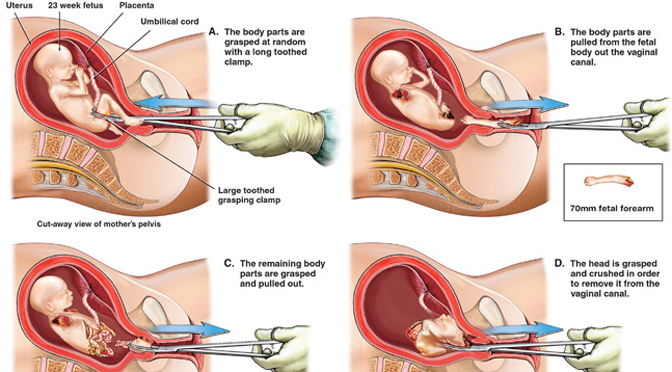When you’re a pro-life activist, you hear a lot of reasons why abortion should remain legal. Among the more popular? That “the right to choose” is constitutionally guaranteed. It’s often said with a tone of certainty, as if further objection has just been rendered moot.
The tone usually changes when you ask where exactly the Constitution specifies this. Replies tend to be a little vague, which isn’t surprising. After all, even the guys who came up with the idea couldn’t give a straight answer.
In Roe v. Wade, the Supreme Court found a right to abortion. Where did they find it? Within the larger “right of privacy.” OK… so where’s that right laid out? Well, it isn’t. “The Constitution,” Justice Blackmun admitted, “does not explicitly mention any right of privacy.” You might think this would pose something of an obstacle; that’s probably why you’re not on the Supreme Court.
In contrast, Blackmun and company regarded the Constitution somewhat like The Da Vinci Code, assembling mysterious pieces of a hitherto unseen puzzle:
In a line of decisions, however, going back perhaps as far as Union Pacific R. Co. v. Botsford, 141 U.S. 250, 251 (1891), the Court has recognized that a right of personal privacy, or a guarantee of certain areas or zones of privacy, does exist under the Constitution.
In varying contexts, the Court or individual Justices have, indeed, found at least the roots of that right in the First Amendment, Stanley v. Georgia, 394 U.S. 557, 564 (1969); in the Fourth and Fifth Amendments, Terry v. Ohio, 392 U.S. 1, 8 -9 (1968), Katz v. United States, 389 U.S. 347, 350 (1967), Boyd v. United States, 116 U.S. 616 (1886), see Olmstead v. United States, 277 U.S. 438, 478 (1928) (Brandeis, J., dissenting); in the penumbras of the Bill of Rights, Griswold v. Connecticut, 381 U.S., at 484 -485; in the Ninth Amendment, id., at 486 (Goldberg, J., concurring); or in the concept of liberty guaranteed by the first section of the Fourteenth Amendment, see Meyer v. Nebraska, 262 U.S. 390, 399 (1923). These decisions make it clear that only personal rights that can be deemed “fundamental” or “implicit in the concept of ordered liberty,” Palko v. Connecticut, 302 U.S. 319, 325 (1937), are included in this guarantee of personal privacy.
They also make it clear that the right has some extension to activities relating to marriage, Loving v. Virginia, 388 U.S. 1, 12 (1967); procreation, Skinner v. Oklahoma, 316 U.S. 535, 541 -542 (1942); contraception, Eisenstadt v. Baird, 405 U.S., at 453 -454; id., at 460, 463-465 [410 U.S. 113, 153] (WHITE, J., concurring in result); family relationships, Prince v. Massachusetts, 321 U.S. 158, 166 (1944); and child rearing and education, Pierce v. Society of Sisters, 268 U.S. 510, 535 (1925), Meyer v. Nebraska, supra.
How did any of this create a right to kill children? Simple: Blackmun and six other justices said it did.
This right of privacy, whether it be founded in the Fourteenth Amendment’s concept of personal liberty and restrictions upon state action, as we feel it is, or, as the District Court determined, in the Ninth Amendment’s reservation of rights to the people, is broad enough to encompass a woman’s decision whether or not to terminate her pregnancy.
Also discussed was “the detriment” that an “unwanted child” can bring. (The detriment that comes with being aborted didn’t get as much attention.)

Neither did the possibility that sexual predators would use abortion to cover up their crimes. Here’s a list of more than fifty who did exactly that.
Nor was it considered that in many cases, the choice to get an abortion would be made by someone other than the woman having it. Some studies suggest more than half of women who abort feel pressure to do so. This can come in the form of financial coercion or personal blackmail, while other times threats of violence are used. Ignoring those threats can be deadly, as women have been shot, stabbed, bludgeoned, burned and smothered for refusing to visit an abortion facility.
Pro-lifers need to remind the presidential contenders that Supreme Court appointments are a major deal for us. Granted, it’s easier to pick suitable nominees when there are plenty of candidates to choose from. That’s why we have to encourage pro-life judges at the state level as well.
In the meantime, we can continue to pursue the avenues open to us, like demanding that federal funds be sent to community health centers instead of Planned Parenthood, America’s largest abortion chain. Of course, it would be nice if we could do more; hopefully we’ll get a Supreme Court that will let us.







